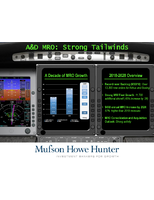Survey shows ad execs support media experimentation.
Press Release Summary:
According to AAF Media Investment Survey 2007, ad executives are strongly committed to complementing traditional media by allocating portion of their budgets to new media properties and experimentation. Newspapers, network TV, and radio were ranked top 3 media categories other than magazines most in need of novel approach. Survey included close to 1,000 advertising industry leaders spread across agency, media, advertiser/client, and other sectors.
Original Press Release:
AAF Survey Shows Overwhelming Majority of Ad Execs Find Innovations Inspire Creativity
Three-Quarters of Respondents Reserve Up to 20 Percent of Budget for Experimentation and New Media Properties
WASHINGTON, D.C., February 6, 2007-The AAF Media Investment Survey 2007 (download the full summary), released today by the American Advertising Federation (AAF), reveals an increasing confidence in navigating the new media ecosystem in 2007. The survey confirms a strong commitment among executives to complementing traditional media by allocating a portion of their budgets to new media properties and experimentation.
The survey also revealed executives' belief that traditionally staid media categories are in need of innovation if they are to remain competitive. Newspapers (51.4 percent), network television (34.5 percent) and radio (33.8 percent) were ranked the top three media categories other than magazines most in need of a novel approach. Within the magazine category, business magazines (at 46 percent) are most in need of a unique approach to shake things up. Women's Service (25 percent), Fashion and Beauty (18.8 percent), Men's (17 percent) and Shelter (12.5 percent) rounded out the top five.
The survey yielded additional findings of interest:
o An overwhelming majority of respondents (87.4 percent) believe that the pace and scope of innovation in the media landscape inspires creativity.
o Seventy-three percent of respondents said that one to 20 percent of their budget is reserved for experimentation and new media properties. Significant, however, is the finding that 12.37 percent of respondents list 21 to 40 percent of their budget as reserved for these items.
o In 2006, the most expected innovations in the media landscape were 1) the availability of TV programs on the Internet, 2) the mass adoption of text messaging in the United States, and 3) the importance of social media/networking as part of the communications plan.
o In 2006, the most surprising innovations in the media landscape were 1) the rush to Second Life virtual community space, 2) the rise of YouTube and 3) the popularization of mash-ups or Web applications that have more than one source.
When asked about approaches to media planning in the coming year, respondents ranked "I am always open to new ways to use traditional media" highest (at 78 percent), with "the right media mix almost always includes a balance of traditional and nontraditional media" (at 75.5 percent), and "the search for new media properties to grow my brand never stops" (at 57.7 percent) second and third highest.
The AAF Media Investment Survey 2007 surveyed close to one thousand advertising industry leaders, spread across agency (38 percent), media (26.9 percent), advertiser/client (13.6 percent) and other (21.4 percent, composed mostly of suppliers and academics) sectors, with the majority being at the director (19 percent), owner (18 percent) or manager (17.6 percent) level. Nearly 31 percent of participants are part of a team that makes the final media investment decision for their company.
A full summary of the survey results can be found here (PowerPoint document, 891k). For more information, contact Mary Hilton, VP - public affairs, at mhilton@aaf.org or (202) 251-3062.
The American Advertising Federation (AAF), headquartered in Washington, D.C., acts as the "Unifying Voice for Advertising." The AAF is the oldest national advertising trade association, representing 50,000 professionals in the advertising industry. The AAF has a national network of 200 ad clubs located in ad communities across the country. Through its 215 college chapters, the AAF provides 6,500 advertising students with real-world case studies and recruitment connections to corporate America. The AAF also has 130 blue-chip corporate members that are advertisers, agencies and media companies, comprising the nation's leading brands and corporations. For more information, visit the AAF's Web site at www.aaf.org.




